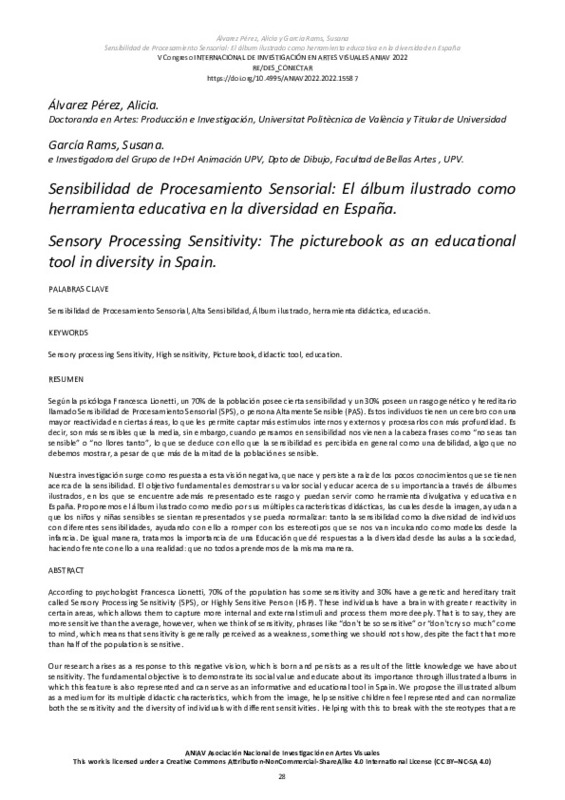JavaScript is disabled for your browser. Some features of this site may not work without it.
Buscar en RiuNet
Listar
Mi cuenta
Estadísticas
Ayuda RiuNet
Admin. UPV
Sensibilidad de Procesamiento Sensorial: El álbum ilustrado como herramienta educativa en la diversidad en España
Mostrar el registro sencillo del ítem
Ficheros en el ítem
| dc.contributor.author | Álvarez Pérez, Alicia
|
es_ES |
| dc.contributor.author | Garcia Rams, María Susana
|
es_ES |
| dc.date.accessioned | 2022-09-13T10:10:15Z | |
| dc.date.available | 2022-09-13T10:10:15Z | |
| dc.date.issued | 2022-07-15 | |
| dc.identifier.isbn | 9788413960272 | |
| dc.identifier.uri | http://hdl.handle.net/10251/185884 | |
| dc.description.abstract | [EN] According to psychologist Francesca Lionetti, 70% of the population has some sensitivity and 30% have a genetic and hereditary trait called Sensory Processing Sensitivity (SPS), or Highly Sensitive Person (HSP). These individuals have a brain with greater reactivity in certain areas, which allows them to capture more internal and external stimuli and process them more deeply. That is to say, they are more sensitive than the average, however, when we think of sensitivity, phrases like “don't be so sensitive” or “don't cry so much” come to mind, which means that sensitivity is generally perceived as a weakness, something we should not show, despite the fact that more than half of the population is sensitive. Our research arises as a response to this negative vision, which is born and persists as a result of the little knowledge we have about sensitivity. The fundamental objective is to demonstrate its social value and educate about its importance through illustrated albums in which this feature is also represented and can serve as an informative and educational tool in Spain. We propose the illustrated album as a medium for its multiple didactic characteristics, which from the image, help sensitive children feel represented and can normalize both the sensitivity and the diversity of individuals with different sensitivities. Helping with this to break with the stereotypes that are instilled in us as models from childhood. In the same way, we treat the importance of an education that responds to diversity from the classroom to society, thus facing a reality: that we do not all learn in the same way. | es_ES |
| dc.description.abstract | [ES] Según la psicóloga Francesca Lionetti un 70% de la población posee cierta sensibilidad y un 30% poseen un rasgo genético y hereditario llamado Sensibilidad de Procesamiento Sensorial, o persona Altamente Sensible (PAS). Estos individuos tienen un cerebro con una mayor reactividad en ciertas áreas, lo que les permite captar más estímulos internos y externos y procesarlos con más profundidad. Es decir, son más sensibles que la media, sin embargo, cuando pensamos en sensibilidad nos vienen a la cabeza frases como “no seas tan sensible” o “no llores tanto”, lo que se deduce con ello que la sensibilidad es percibida en general como una debilidad, algo que no debemos mostrar, a pesar de que más de la mitad de la población es sensible.Nuestra investigación surge como respuesta a esta visión negativa, que nace y persiste a raíz de los pocos conocimientos que se tienen acerca de la sensibilidad. El objetivo fundamental es demostrar su valor social y educar acerca de su importancia a través de álbumes ilustrados en los que se encuentre además representado este rasgo y puedan servir como herramienta divulgativa y educativa en España. Proponemos el álbum ilustrado como medio por sus múltiples características didácticas, las cuales desde la imagen, ayudan a que los niños y niñas sensibles se sientan representados y se pueda normalizar tanto la sensibilidad como la diversidad de individuos con diferentes sensibilidades. Ayudando con ello a romper con los estereotipos que se nos van inculcando como modelos desde la infancia. De igual manera, tratamos la importancia de una educación que dé respuestas a la diversidad desde las aulas a la sociedad, haciendo frente con ello a una realidad: que no todos aprendemos de la misma manera. | es_ES |
| dc.format.extent | 7 | es_ES |
| dc.language | Español | es_ES |
| dc.publisher | Editorial Universitat Politècnica de València | es_ES |
| dc.rights | Reconocimiento - No comercial - Compartir igual (by-nc-sa) | es_ES |
| dc.subject | Sensibilidad de Procesamiento Sensorial | es_ES |
| dc.subject | Alta Sensibilidad | es_ES |
| dc.subject | Álbum ilustrado | es_ES |
| dc.subject | Herramienta didáctica | es_ES |
| dc.subject | Educación | es_ES |
| dc.subject | Sensory processing Sensitivity | es_ES |
| dc.subject | High sensitivity | es_ES |
| dc.subject | Picturebook | es_ES |
| dc.subject | Didactic tool | es_ES |
| dc.subject | Education | es_ES |
| dc.title | Sensibilidad de Procesamiento Sensorial: El álbum ilustrado como herramienta educativa en la diversidad en España | es_ES |
| dc.title.alternative | Sensory Processing Sensitivity: The picturebook as an educational tool in diversity in Spain | es_ES |
| dc.type | Capítulo de libro | es_ES |
| dc.type | Comunicación en congreso | es_ES |
| dc.identifier.doi | 10.4995/ANIAV2022.2022.15587 | |
| dc.rights.accessRights | Abierto | es_ES |
| dc.contributor.affiliation | Universitat Politècnica de València. Departamento de Dibujo - Departament de Dibuix | es_ES |
| dc.contributor.affiliation | Universitat Politècnica de València. Facultad de Bellas Artes - Facultat de Belles Arts | es_ES |
| dc.description.bibliographicCitation | Álvarez Pérez, A.; Garcia Rams, MS. (2022). Sensibilidad de Procesamiento Sensorial: El álbum ilustrado como herramienta educativa en la diversidad en España. Editorial Universitat Politècnica de València. 28-34. https://doi.org/10.4995/ANIAV2022.2022.15587 | es_ES |
| dc.description.accrualMethod | OCS | es_ES |
| dc.relation.conferencename | V Congreso Internacional de Investigacion en Artes Visuales ANIAV 2022. RE/DES Conectar | es_ES |
| dc.relation.conferencedate | Julio 06-08, 2022 | es_ES |
| dc.relation.conferenceplace | Valencia, España | es_ES |
| dc.relation.publisherversion | http://ocs.editorial.upv.es/index.php/ANIAV/ANIAV2022/paper/view/15587 | es_ES |
| dc.description.upvformatpinicio | 28 | es_ES |
| dc.description.upvformatpfin | 34 | es_ES |
| dc.type.version | info:eu-repo/semantics/publishedVersion | es_ES |
| dc.relation.pasarela | OCS\15587 | es_ES |








